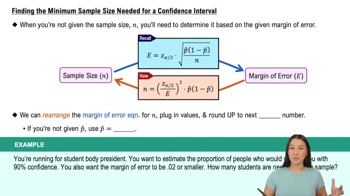Table of contents
- 1. Intro to Stats and Collecting Data55m
- 2. Describing Data with Tables and Graphs1h 55m
- 3. Describing Data Numerically1h 45m
- 4. Probability2h 16m
- 5. Binomial Distribution & Discrete Random Variables2h 33m
- 6. Normal Distribution and Continuous Random Variables1h 38m
- 7. Sampling Distributions & Confidence Intervals: Mean1h 3m
- 8. Sampling Distributions & Confidence Intervals: Proportion1h 12m
- 9. Hypothesis Testing for One Sample1h 1m
- 10. Hypothesis Testing for Two Samples2h 8m
- 11. Correlation48m
- 12. Regression1h 4m
- 13. Chi-Square Tests & Goodness of Fit1h 20m
- 14. ANOVA1h 0m
8. Sampling Distributions & Confidence Intervals: Proportion
Confidence Intervals for Population Proportion
Problem 7.1.9
Textbook Question
Formats of Confidence Intervals. In Exercises 9ŌĆō12, express the confidence interval using the indicated format. (The confidence intervals are based on the proportions of red, orange, yellow, and blue M&Ms in Data Set 38 ŌĆ£CandiesŌĆØ in Appendix B.)
Green M&Ms Express 0.116 < p < 0.192 in the form of p +-E.
 Verified step by step guidance
Verified step by step guidance1
Identify the given confidence interval: 0.116 < p < 0.192. Here, p represents the population proportion, and the interval provides the range of plausible values for p.
To express the confidence interval in the form p ┬▒ E, calculate the midpoint of the interval. The midpoint is the point estimate (▒Ķ╠é) and can be found using the formula: , where 'Lower' is 0.116 and 'Upper' is 0.192.
Next, calculate the margin of error (E). The margin of error is the distance from the midpoint to either endpoint of the interval. Use the formula: or equivalently .
Substitute the calculated midpoint (▒Ķ╠é) and margin of error (E) into the format p ┬▒ E. This will give the confidence interval in the desired form.
Verify your result by checking that the reconstructed interval (▒Ķ╠é - E to ▒Ķ╠é + E) matches the original interval (0.116 to 0.192). This ensures the conversion was done correctly.
 Verified video answer for a similar problem:
Verified video answer for a similar problem:This video solution was recommended by our tutors as helpful for the problem above
Video duration:
1mPlay a video:
Was this helpful?
Key Concepts
Here are the essential concepts you must grasp in order to answer the question correctly.
Confidence Interval
A confidence interval is a range of values, derived from sample statistics, that is likely to contain the true population parameter. It is expressed as an interval estimate, typically in the form of (lower limit, upper limit), and indicates the degree of uncertainty associated with a sample estimate. The width of the interval reflects the level of confidence, with wider intervals indicating more uncertainty.
Recommended video:

Introduction to Confidence Intervals
Margin of Error (E)
The margin of error (E) quantifies the amount of random sampling error in a survey's results. It represents the maximum expected difference between the true population parameter and a sample estimate. In the context of confidence intervals, it is calculated as half the width of the interval, allowing for the expression of the interval in the form of p ┬▒ E, where p is the sample proportion.
Recommended video:

Introduction to Confidence Intervals
Proportion
A proportion is a statistical measure that represents the fraction of a whole, often expressed as a decimal or percentage. In the context of the question, it refers to the proportion of a specific color of M&M's (e.g., green) in a sample. Understanding proportions is essential for calculating confidence intervals, as they serve as the basis for estimating population parameters.
Recommended video:
Guided course

Difference in Proportions: Hypothesis Tests

 5:45m
5:45mWatch next
Master Constructing Confidence Intervals for Proportions with a bite sized video explanation from Patrick
Start learningRelated Videos
Related Practice






